Sometimes nothing satisfies a salt craving quite like some olives.
But next time you reach for a can at the shops, you might want to look a bit closer at the ingredients list.
Sophia Smith Galer, a British TikTok influencer and writer, warns that black olives are not quite what they seem.
In her viral video, she explains that black olives are packed with additives to remove their bitterness and change their colour.
It means olives marketed as black might not be naturally black at all.
‘You’re probably buying fake black olives from the supermarket,’ she said in the clip, which has more than 119,000 views and 6,000 likes.
Typically, in a cheap can of supermarket black olives, all the individual olives ‘taste and look very similar’, she explains.
But that’s because they’re ‘all turned the exact same black colour’ with ‘one particular ingredient’.
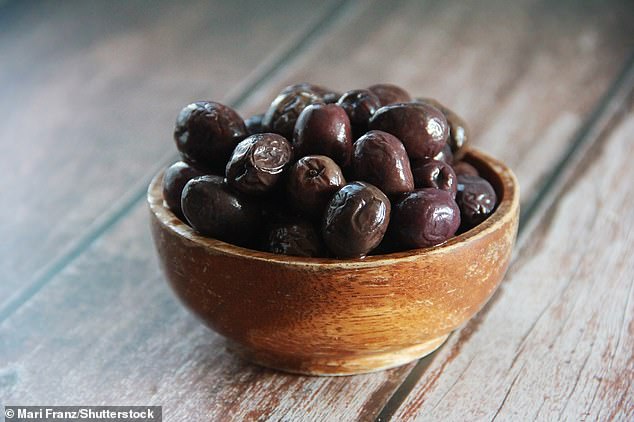
Green olives are picked before fully ripened, whereas black olives have been left to ripen fully. But olives may have been packed with a compound to make them appear darker (file photo)
It’s a little-known fact that green olives are the ones that have been picked before they’re fully ripe, whereas black olives have been left to ripen fully.
Whether green or black, supermarket olives are often soaked in sodium hydroxide, which softens them and removes their bitterness.
Professor Gunter Kuhnle, food scientist at the University of Reading, said sodium hydroxide is ‘quite commonly used in food processing’.
‘It’s used for the processing of many grains such as maize, peeling of foods, but it’s not that often on the label,’ he told MailOnline.
Lactic acid is also added to olives in brine, as it lowers their pH, acting as a natural preservative against the growth of unwanted pathogens.
But there’s another additive that you’ll commonly find on the ingredients list of black olives – ferrous gluconate.
Ferrous gluconate, an iron compound used in the olive industry, imparts a uniform jet black colour to the little round fruits.
It means that black olives are often actually green ones that have had the black compound added to make them darker, the TikToker explains.

Although she holds a can from Waitrose, multiple UK supermarkets sell their own brand of black olives containing the little-known additive
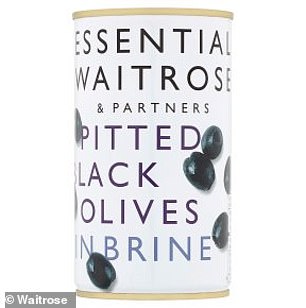
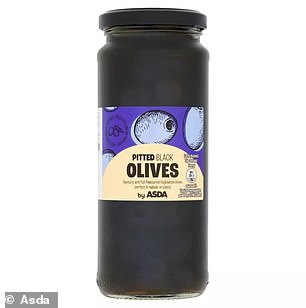
Ferrous gluconate is also used as a supplement to combat iron deficiency, but side effects can include nausea, vomiting and stomach pain
‘Its job is to bind to compounds in the olives to oxidise them and turn them all into this uniform black colour,’ explained Smith Galer, who is also a former fellow with Brown University’s Information Futures Lab.
‘Just because they’re called black olives, doesn’t mean they were naturally black – they weren’t, they were green.’
Ferrous gluconate (E579) is approved as a food additive by the Food Standards Agency in the UK and the Food and Drug Administration in the US.
It is also used as a supplement to combat iron deficiency, but side effects can include nausea, vomiting and stomach pain.
‘Proper’ black olives without the additive will often be a little bit softer than green ones simply because they were left to ripen before being picked and processed.
Although the influencer shows us a can of Waitrose black olives, other British big grocery giants sell black olives containing the additive too.
MailOnline found Asda, Sainsbury’s and Tesco are selling their own brand of black olives containing the ‘stabiliser’ ferrous gluconate.
MailOnline has contacted all four of the supermarkets for comment.
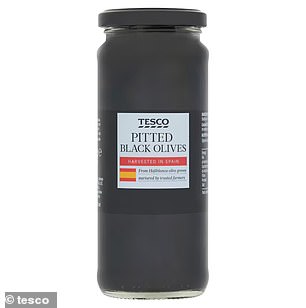
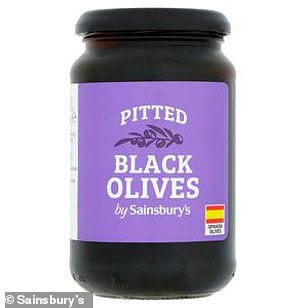
MailOnline found ferrous gluconate in supermarket-brand black olives sold by Sainsbury’s, Tesco, Waitrose and Asda
Not all black olives from these supermarkets will contain ferrous gluconate, however.
Many black olives of a good enough quality will have been properly left to ripen before picking, packing and shipping.
Naturally black olives (those left to ripen) tend to be sweeter and slightly softer, with less bitterness compared to green olives.
For example, at the end of the video clip, Smith Galer eats Beldi olives from Morocco, a naturally-wrinkly variety served cured in salt.
‘You can if you want buy real black olives in the supermarket,’ she adds. ‘Those are the real things.’
